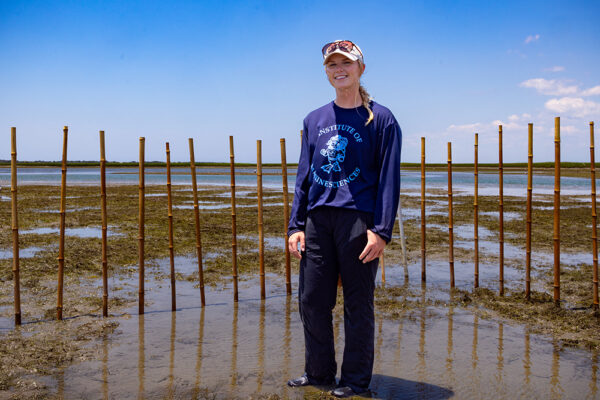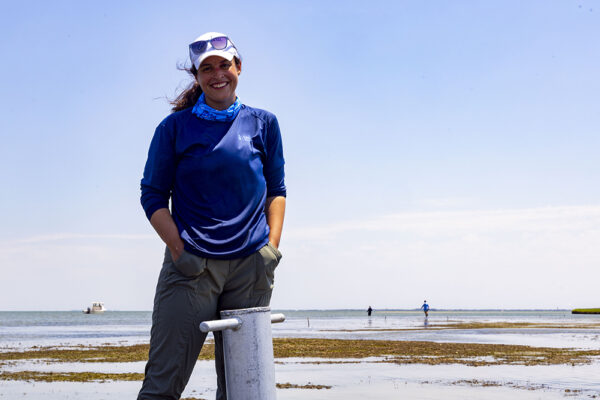Eelgrass is a type of seagrass that looks like land grass but lives in shallow saltwater, forming dense seafloor meadows that provide shelter for young marine life like blue crabs, shrimp, and fish, protecting them from predators.
Along with providing essential habitats and food for a variety of species, these underwater plants also improve water quality, mitigate coastal erosion, and reduce the impact of wave energy.
“Seagrass is an incredibly dynamic system,” explains Nadya Gutierrez, a PhD student at the UNC Institute of Marine Sciences (IMS). “The critters just like to hang out in it. Shrimp love it, and I tell anyone that likes shrimp that they should love seagrass as well.”
But these plants have been heavily degraded by urban development, dredging, pollution, and sediment runoff. It is declining worldwide, with North Carolina’s losses matching or sitting just below the global average each year.
Each spring in North Carolina, nearly all eelgrass dies off — only to regrow from tiny, sesame-like seeds. While each square meter can produce tens of thousands of seeds, only a small number of them become new plants.
This discrepancy has prompted researchers to ask: Where do the remaining seeds go? What’s happening to them? Are they being consumed by marine animals or dispersed by water?
IMS PhD students Heather Bruck and Nadya Gutierrez are searching for answers to these questions, examining how marine animals and the coastal landscape might be affecting eelgrass seed distribution along North Carolina’s coast. Bruck is studying if animal activity disrupts the spread of seeds, while Gutierrez is studying seed abundance in patchy meadows to assess landscape effects.
Impact Report
![]()
The UNC Institute of Marine Sciences (IMS) offers immersive research experiences that connect students and scientists with N.C.’s coastal ecosystems and communities. To date, IMS has trained 500+ undergraduate and graduate students.

North Carolina is home to 100,000 acres of seagrass — the second-largest area on the East Coast — and has lost about 6,000 acres over the past two decades, according to the N.C. Department of Environmental Quality. Just 100 acres of seagrass can support 80,000 fish and creatures like crabs and shrimp, helping to preserve ecosystems and fisheries across the state.
“Eelgrass needs seeds to be able to replenish and grow, and we don’t know how much seed loss actually can happen before the meadows start to get hurt from the lack of seeds,” Bruck explains.
Ravenous rays
Eelgrass seeds are released in late spring, many of which sink into the sediment, forming a seed bank that remains dormant until fall. Bruck wants to know what happens to these seeds while they’re buried in the seafloor — and she suspects stingrays might have an impact.

Heather Bruck (photo by Megan Mendenhall)
Stingrays have flat, wide bodies and live in shallow water. They hunt by suctioning water through their mouths and gills to uncover prey hidden beneath the sand. This behavior creates large bowl-like depressions in the seafloor called feeding pits.
“Imagine somebody takes a mixing bowl and just scoops sand out,” Bruck says. “We don’t really know what happens to seeds that were once in that sediment.”
Last summer, she found fewer seeds in feeding pits than in undisturbed sediment. Now, she is trying to uncover if stingrays are mixing the seeds around or unintentionally eating them. To find out, she’s bringing the marine predators into her lab and placing them in a tank lined with sediment. After a feeding pit is formed, she’ll examine the tank to see whether the seeds were eaten or simply shifted.
“So, let’s say there’s 100 seeds when it starts, but only 50 after this feeding pit is created,” Bruck explains. “To me, that’s a sign that there is nowhere else for these seeds to have gone except inside the stingray.”
She’ll also check whether seeds remain intact after passing through a stingray’s digestive system. If they do, stingrays might actually help spread the seeds to new areas.
“I’m trying to find a piece of the puzzle that explains the loss of seeds over time — and if stingrays are one of those pieces,” she says.
Edge effects
North Carolina’s underwater meadows are changing. Once made up of large, continuous beds, they’re now breaking apart into smaller, patchier ones. Scientists believe several factors may be driving this shift, including poor water quality, coastal development, human activities, and natural cycles.

Nadya Gutierrez (photo by Megan Mendenhall)
To better understand what’s happening, Gutierrez is studying how these patchy meadows affect the seed banks that help eelgrass grow back each year. Notably, patchier meadows tend to have more edges — a pattern that is important for her research.
“You’ve increased the relative amount of edge, and it could be that these edges aren’t producing quite as many seeds,” she says. “So, we could be seeing a lower overall production of seagrass seeds. And that could make it harder for the seagrass to come back the following season.”
To dig deeper, Gutierrez collected 175 large vegetative cores from all sites in her study. She measured how dense the plants were, counted their reproductive shoots, and identified other seagrass species that might be competing with eelgrass — since competition could affect seed production.
She’s also examining the eelgrass’ reproductive lifecycle by tracking the number of seeds that enter the seedbank in June and persist through October, just before they germinate. This will allow her to investigate how the seed bank dynamics change throughout time in patchy systems.
The implications of this research extend far beyond the plants themselves.
“If we lose our seagrass, we could lose our shrimp or our blue crabs or fish that we like to eat,” Gutierrez says. “It’s really important to understand how these systems are changing so that we can better prepare our fisheries industry, fisheries management, and coastal zone management.”

